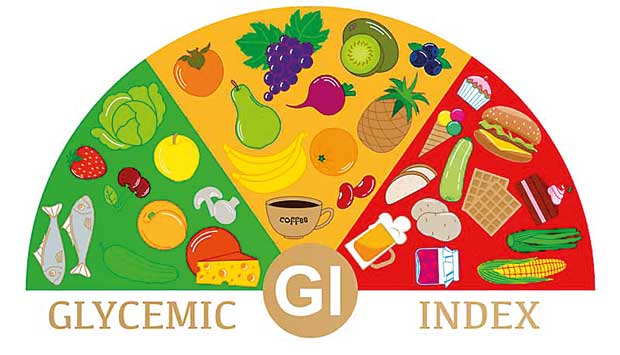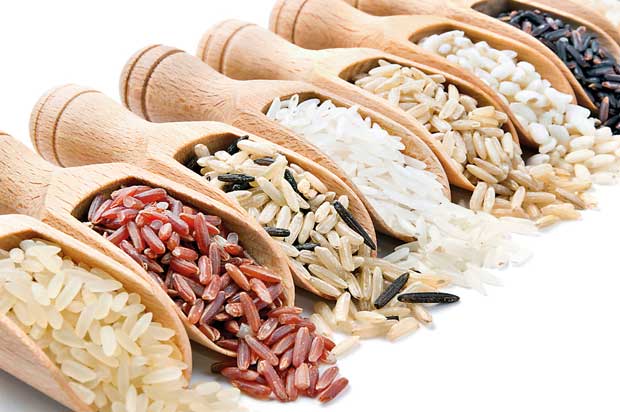09 Mar 2018 - {{hitsCtrl.values.hits}}

 As Sri Lankans, we consume a carbohydrate based diet since rice is our staple meal. The total carbohydrate in food includes starch, sugar and fibRE. More refined, fast release, staple carbohydrate food are identified as one of the major risk factor for the development of obesity and diabetes like non-communicable diseases.
As Sri Lankans, we consume a carbohydrate based diet since rice is our staple meal. The total carbohydrate in food includes starch, sugar and fibRE. More refined, fast release, staple carbohydrate food are identified as one of the major risk factor for the development of obesity and diabetes like non-communicable diseases.
During the digestion of food, both starch and sugar breakdown into glucose and is the cause for elevated blood glucose levels. There is an index that indicates the physiological effect of carbohydrate food sources which is known as the ‘Glycemic Index’.
Glycemic Index (GI)
Glycemic Index (GI) is a number that indicates the blood glucose raising potential of digestible carbohydrate rich foods. The carbohydrate in food is digested at different rates releasing glucose into the blood stream. According to that rate, different food are classified as low (GI <55), medium (56 >GI<69) or high (GI >70) GI foods.
Low, medium and high GI food sources
Low GI: These are carbohydrates that break down slowly during digestion, release glucose gradually into the bloodstream and keep blood sugar levels steady. Soy products, beans, fruits, low fat dairy food, pasta, porridge, lentils, minimally processed grains, nuts and non-starchy vegetables are few examples for low GI foods. Medium GI: These are carbohydrates that break down moderately during digestion and release glucose moderately into the bloodstream. Medium GI foods are basmati rice, white and sweet potatoes, corn, white rice, etc. High GI: These are carbohydrates that break down quickly during digestion, release glucose rapidly into the blood stream and cause rapid fluctuations in blood sugar levels. Ex: corn chips, watermelon, honey, doughnuts, French fries, cornflakes, baked potato, dates etc.
Importance of GI for a healthy life
The GI is a useful nutritional concept which gives new view and relationship between the physiological effects of carbohydrate-rich food and our health. GI is important to minimize the insulin related problems by identifying and avoiding food which have the greatest effect on our blood glucose level. Our body will perform well when our blood glucose level is kept relatively constant. If our blood glucose level drops too low, we become lethargic and or experience increased hunger. And also if blood glucose level rise too high, the pancreas secretes more insulin to drop down the excess blood glucose level, primarily by converting the excess sugar to stored fat. Therefore, if we clearly identify the low, medium and high GI food, then we have a great opportunity to protect our health from most of the diseases. For example, consumption of low GI food might be useful in the prevention and reducing the risk of type 2 diabetes, coronary heart diseases, several types of cancer, obesity, chronic kidney diseases, formation of gall stones, neural tube defects, formation of uterine fibroids and prolong physical persistence and improve insulin sensitivity. And GI is also a useful tool in planning diets for diabetic patients and is a key player in controlling diabetes. Moreover, GI of food is different when it is eaten alone than when it is combined with other food. When we eat food that has high GI value, we can combine it with other low or medium GI food to balance the effect on blood glucose level. The consumption of high GI food is also very important since most nutritious food have a higher GI value. Therefore, the use of GI needs to be balanced with basic nutrients for a healthy life.
Factors that affect the GI of food
The GI of food is dependent on several factors. Most of international and local research studies are focusing on how these factors effect on physical and chemical properties of food and eventually how it influences the GI value of foods.

1.Variety
The GI of rice is affected by the proportion of amylose to amylopectin in the grains. The higher the proportion of amylopectin gives higher GI, which is made up of branched-starch molecules. Hence it can more easily break down in the gut than the single chain amylose.
As indicated in rice based research study, all varieties of raw red rice do not have a low GI value compared with white rice. Only certain varieties of parboiled red rice have low GI while red raw, white raw, red basmati and white basmati have high GI whereas keeri samba has a
medium GI value. However, parboiled naadu belongs to a lower GI category compared to Indian basmati rice and Pakistan basmati rice. The parboiling process lowers the glycemic index, by changing its physico-chemical properties.
2.Cooking methods
The application of heat and moisture for a longer period of time disorganizes the crystalline structure. During cooking, heat and water soften the hard compact starch granules by absorbing water, swell and then break. As a result, starch (amylose and amylopectin) molecules are released leading to gelatinization with breakdown of the crystalline structure. This makes starch more bio-available for enzymic action leading to increased glucose absorption. Thus, physical-chemical properties of starch and degree of starch gelatinization influence the glycemic response and the GI of a food. This indicates that food subject to wet heat processing (boiling, steaming) tended to elicit higher GI values than the foods that are subjected to dry heat processing (roasting).
3.Dietary component
Food or meal components such as dietary fiber, moisture and protein contents affect the glycemic response. The presence of higher dietary fiber lowers the GI in mixed meals and legumes since fiber protects the starchy carbohydrate from digestive enzymes or slows digestion process in the digestive tract and as a result of that, conversion of the carbohydrate to glucose is slowed down. Moreover, protein also decreases the GI level because, protein will promote the additional insulin secretion, resulting in lower blood glucose level. And also, both protein and fat delay stomach emptying, thereby slowing the rate, so the carbohydrate can be digested and absorbed. Furthermore, high moisture in green leafy porridge contributes to decrease the GI.
4.Particle size
Starch in carbohydrate food exists in the form of large granules. Grinding, rolling, pressing a kernel or other starch food can disrupt the granules and increases GI since disruption of starch granules facilitates the availability of amylose or amylopectin starch large molecules for digestion. Some research studies have shown that industrially milled flour with relatively smaller particle size distribution has higher GI compared to food made of stone grounded flour where the particle size is larger.
5.Ripeness of fruit
When fruit is ripe, starch converts to sugar and increases the GI. In conclusion, both amount and types of carbohydrate in food affect blood glucose level. Studies also show that the total amount of carbohydrate in food is a stronger predictor of blood glucose than GI.
Both of these quantity and quality of carbohydrate in food are measured by Glycemic Load (GL). Thus it is better to calculate the GL using the GI rather than using only GI to guide the diet plan. (The writer holds MSc. Degree in Industrial and Environmental Chemistry from the University of Kelaniya and BSc. Degree in Food Production and Technology Management from the Wayamba University of Sri Lanka).
22 Dec 2024 8 hours ago
22 Dec 2024 9 hours ago
22 Dec 2024 22 Dec 2024
22 Dec 2024 22 Dec 2024
22 Dec 2024 22 Dec 2024